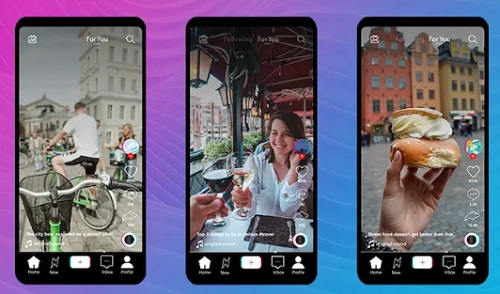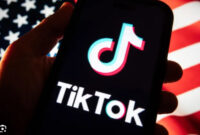From engaging videos that highlight less popular destinations to tips on packing and transportation, TikTok has become an essential source of information and inspiration for global exploration.
However, it also sparks debate, as creators reveal ‘hidden’ locations that subsequently become crowded with tourists and sometimes promote unethical behavior. Here’s everything you should know about the platform’s impact on travel as we understand it.
What sets TikTok apart?
Being a relatively new player compared to YouTube and Instagram, TikTok debuted in 2016 and has since amassed over one billion monthly active users. Its quick format—short, shareable clips—and captivating algorithm have made it extremely popular among younger audiences, with 70% of users under the age of 34. According to TikTok’s own data insights, there has been a 410% rise in travel-related content views since 2021.
Content creator Emma Cooke (@petite.blondine) believes that the authenticity of the videos contributes to their performance. “If a picture carries 1,000 words, a video conveys 10,000,” she expresses. “It’s far more challenging to manipulate a video than it is to alter an image. TikTok travelers seek genuine experiences.”
In what ways are travelers using TikTok?
Over 70% of TikTok’s audience in Europe indicates they’re likely to plan a vacation based on suggestions they’ve encountered on the platform. In fact, research by Adobe revealed that more than 60% of Gen Z Americans have utilized TikTok as a search engine. Inputting a search term like ‘top things to do in Paris’ yields a plethora of videos, prioritized by popularity — and the algorithm will refine its suggestions based on your interests the next time you browse. TikTok is also honing in on geolocation, offering content based on your location as you navigate.
Gen Mohacsy, a 25-year-old medical secretary from the UK, states, “I consistently use TikTok to craft itineraries for my travels — it often outperforms Tripadvisor. Watching videos can provide insights into a location that reading alone cannot. That’s how I discovered Auckland’s night markets while touring New Zealand.”
What trends have surfaced?
Many trends have emerged, ranging from the strange to the practical. This year has introduced the ‘airport tray aesthetic’ trend, where creators showcase their travel items creatively arranged in airport security bins. There’s also ‘raw-dogging,’ a term that now describes enduring long-haul flights without any entertainment, along with ‘grocery store tourism,’ which entails exploring the aisles of international supermarkets. Additionally, according to a report from Advantage Travel Partnership, there has been a surge in interest regarding ‘travel dupes,’ referring to finding cheaper and less crowded alternatives to popular destinations (like opting for Montenegro over Croatia).
What are some of the drawbacks of TikTok?
TikTok attracts a diverse range of content creators whose insights can be incredibly beneficial for travelers. However, they also run the risk of causing negative impacts by directing large numbers of visitors to locations ill-equipped to handle them.
Many tourist spots have suffered due to their newfound popularity. A viral video from 2021 showcasing Jianfengling mountain and Daguang Dam Reservoir in China quickly turned the site into a hotspot almost overnight. A study published in the Journal of Outdoor Recreation and Tourism noted that while tourists improved the local economy, they also led to increased traffic and overcrowding, straining the region’s infrastructure.
Some businesses are starting to push back, like Dae, a café in New York, which established a no-video policy last year, citing that, “The TikToks… have become a bit overwhelming for us.”
Furthermore, there’s the challenge of promoting unethical tourism. Responsible travel is a significant concern for TikTok users, with posts tagged #SustainableTravel racking up 78.1 million views. However, when Dr. Natara Loose, an American veterinarian, traveled to Mauritius this year, she expressed shock at the numerous boats offering tours to swim with dolphins, an activity that is illegal in Mauritius but frequently advertised on TikTok.
Whether for better or worse, it’s evident that the platform has a tremendous influence on travel, especially among younger audiences — and it appears to be here to stay.
Nearly two-thirds who use social media for trip planning make a decision based on that content
Originally, social media platforms were basic sites meant for sharing life updates with family, friends, and acquaintances, but they have now evolved into a vibrant ecosystem that includes users, brands, and influencers.
Nearly 17 years after Facebook first introduced advertising, the popularity of social media marketing and social commerce continues to grow. Marketers are eager to engage on social media where their customers are present, meticulously crafting strategies to attract both potential and current customers into their sales funnel.
These platforms can provide a straightforward route for products with quicker and easier purchasing options; categories like fashion and beauty have seen significant achievements through social marketing. However, the travel sector still faces challenges.
On one hand, social media content has been instrumental in boosting tourism in certain destinations, sometimes leading to issues of overtourism. On the other hand, many organizations find it difficult to assess the real effectiveness of their social strategies. This uncertainty arises from long conversion times, complicated digital pathways to bookings, and the absence of reliable attribution methods for social channels.
Phocuswright’s most recent travel research report titled Social Media Usage Approach in Travel, along with a forthcoming broader research series, specifically examines how social media platforms are utilized for travel, moving beyond general social marketing trends observed in other sectors. The report investigates the platforms used for different aspects of a trip and how travelers perceive various account types and platforms in terms of providing valuable information. It also looks into the social media behaviors related to travel, detailing what travelers seek when they follow branded accounts, engage with content, share their own experiences, or formally tag and mention travel brands.
By gaining a clearer understanding of the demographics that engage with social media and the motivations for their interaction, brands can strategically position themselves to enhance the effectiveness of their social marketing efforts.
The majority of travelers (57%) use social media while planning their trips. It serves multiple purposes, including discovering ideas, obtaining general travel information, shopping, making bookings, and sharing content on their pages.
The predominant way travelers incorporate social media into their trips is through sharing. Almost two-thirds of social media users posted content on platforms (excluding YouTube) during a recent trip. These contributions consist of either permanent posts to the feed or temporary stories that vanish after 24 hours.
For social media users, these platforms rank as one of the top online resources for generating trip ideas, closely following general search results. Additionally, the amount of time spent consuming travel-related content on social media has a measurable effect: 62% of social users made a specific travel decision after engaging with social media content.
Interested in more insights on all things social? Phocuswright’s Social Media Usage Approach in Travel is part of a detailed consumer research study that investigates the nuances of how social media platforms are employed for travel. Key inquiries addressed include:
Which platforms are utilized for specific trip components, and how do travelers assess which account types and platforms provide them with the most useful information?
What do travelers seek when following branded accounts, expressing approval for content, sharing their own experiences, or formally tagging and mentioning travel brands?
Do different demographic segments interact with the platforms in distinct ways? If they do, what drives those differences?
The popularity of social media has surged. It has changed how we interact with each other, access information, and make purchases. The travel and tourism sector has experienced a major shift in the last decade due to the rise of social media. A survey indicates that approximately 43% of travelers won’t consider a destination unless they first find it on social media. The hashtag “travel” boasts over 74.4 billion views on TikTok, while more than 624 million travel-related posts exist on Instagram. These figures highlight the significant influence of social media on prospective travelers, its powerful role in the travel industry, and its capacity to showcase various destinations.
Social Media Inspires Travel
Social media can erase barriers and unite people. This creates multiple opportunities for individuals to travel, connect with different cultures, and discover new locations. The rise of social media has made trip planning easier and allowed travel experiences to be shared, inspiring others to pursue their own adventures. It has transformed how individuals gather information about travel destinations. The extensive content available on digital and social media helps travelers gain expectations about their destination and makes it simpler to find unique and lesser-known places they may not have heard of previously.
Increased Travel Knowledge
Thanks to social media platforms, finding information about any location has become quick and effortless. With thousands of travel influencers and millions of travel-related posts at our disposal, there is a vast amount of data regarding various locations. A considerable number of travelers now choose holiday spots based on the content they encounter on social media platforms. Information on exotic locales, accompanied by beautiful visuals, is readily accessible to modern travelers and motivates them to visit these places.
Influences Travel Decisions
As per a survey, more than 35% of travelers turn to social media for travel inspiration. The impact is even greater among younger generations, with 50% of travelers under 40 using social media as a source of inspiration. A large portion of millennials, who typically seek experiential travel, often make their trip decisions based on the Instagram appeal of a certain destination. Moreover, social media has simplified travel. Nearly every aspect of the travel journey, from planning to booking to customer service, can now be managed through a social media platform. This interaction also allows tourists to connect seamlessly with locals, providing valuable insights and creating chances for more authentic experiences.
Research and Reviews
The growth of social media has resulted in a more transparent travel environment. People are increasingly likely to share their experiences, enabling travelers to understand both the advantages and disadvantages of specific destinations. This abundance of information acts as a useful resource for making knowledgeable choices. Individuals also invest a considerable amount of time researching prior to traveling to a new place. Online reviews have become a crucial tool for making informed decisions on lodging, dining, local attractions, and more.
Influencer Marketing
Through social media, travelers can share their experiences with a wider audience than ever, leading to the emergence of “influencer” travelers who leverage their online followings to encourage others to visit similar spots. Content in various formats, such as reels, shorts, and vlogs, has gained traction as consumers explore different locations and seek valuable information for planning their next trips. Given their large follower counts, influencers can significantly influence their followers’ travel choices and have become essential partners for travel companies aiming to collaborate with them to advertise their services and increase public awareness.
The aforementioned points clearly illustrate that social media plays a vital role in the travel industry. It assists in inspiring travelers, shaping their travel choices, and promoting diverse travel destinations.
Social Media and the Travel Industry
Social media has become a vital resource for the travel sector, providing various benefits for hotels, travel agencies, and online travel organizations (OTAs). With billions of active users on prominent social platforms like Facebook, Instagram, Twitter, WhatsApp, and TikTok, businesses in the tourism industry have access to unmatched outreach. These social media channels offer marketing possibilities that enable travel marketers to create thorough strategies and engage their intended audience effectively. Additionally, these platforms facilitate the development of more immersive and tailored campaigns, enticing users with promotions and giveaways. Companies also utilize these platforms to engage with customers by answering their posts, inquiries, and messages while offering guidance about their services.
Social media equips businesses with powerful resources to connect with large audiences and foster relationships with individuals worldwide. It also allows companies to assess and analyze the effectiveness of their marketing endeavors, track customer involvement and conversions, and refine their campaigns for optimal outcomes.
Thus, it can be confidently asserted that social media has evolved into an indispensable element of the strategic frameworks employed by tourism firms. It has become an essential business instrument owing to its broad reach, effective customer service, and user-friendly booking alternatives. As reported by the International Tourist Research Centres, 88% of tourism enterprises actively use social media platforms to market travel and gauge consumer sentiments.
The Challenges posed by the Digital Media
While the utilization of social and digital media has substantially benefited the tourism sector, leading to considerable sales increases and enhanced customer engagement, it is crucial to recognize the various challenges these platforms present. The brand image of a business plays a vital role in its success and performance; however, negative interactions and reviews on social media may hinder potential customers from pursuing travel plans or engaging with the brand. Social media can also facilitate the distribution of misinformation, which can adversely affect the tourism sector and discourage travelers from visiting particular destinations. Furthermore, companies must be aware that privacy legislation differs from one nation to another. Content permissible in one country might not be acceptable in another, so businesses must stay informed about the latest rules and regulations. Additionally, social media campaigns can represent a significant cost. Companies must manage their budgets carefully to ensure their campaigns are both effective and financially viable.
Ultimately, it is crucial for businesses to exercise caution when leveraging social media for marketing campaigns and remain mindful of the potential risks involved. With appropriate strategies and methods, social media can serve as an influential tool in propelling travel and tourism enterprises toward success.
Conclusion
It is evident that the growing impact of social media has substantially influenced the tourism sector, and this effect continues to gain traction. A large segment of leisure travelers relies on social media for travel inspiration and for sharing their experiences, making it an essential tool for travel companies. On average, a traveler engages in over 400 digital interactions prior to making a booking choice. This implies that not only does digital media motivate travel, but it also serves as a reliable source of information, validation, and recommendations. Therefore, targeting potential clients, interacting with current customers, and promoting services are now integral parts of the strategic operations of travel and tourism organizations.
Social media platforms allow companies to forge direct connections with travelers, providing crucial insights into their behaviors and preferences. Brands have capitalized on the vast reach, paid promotion, and advanced targeting features available through social media to broaden and diversify their audience base, engaging with a wider range of individuals globally. Looking ahead, digital media has the potential to become one of the greatest influencers in the global travel industry, driving growth while continuously connecting more travelers to their preferred brands.
In summary, social media is a permanent fixture, and businesses must be prepared to leverage its vast reach and potential. With suitable strategies and approaches, it can become an invaluable asset in aiding the success of travel and tourism companies.



